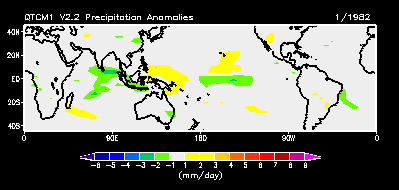Introduction
QTCMs are models of intermediate complexity suitable for the modeling
of tropical climate and its variability. It occupies a
niche among climate models between complex general circulation models
and simple models.
The primitive-equation-based dynamical framework
is constructed using analytical solutions from the quasi-equilibrium
convective parameterization as the first basis function in a
Galerkin representation of vertical structure.
A uniqueness of the QTCM is its balanced treatment of
dynamics and physical parameterizations. It includes a
linearized longwave radiation scheme,
simple cloud prediction and shortwave radiation schemes, and the
Simple-Land (SLand)
land model.
|

QTCM1 (version 2.2):
Anomalous
precipitation from a simulation forced by observed sea surface
temperatures 1982-1998.
|